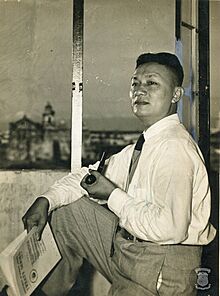Justiniano Montano facts for kids
Quick facts for kids
Justiniano Montano
|
|
|---|---|
 |
|
| Senator of the Philippines | |
| In office December 30, 1949 – December 30, 1955 |
|
| Member of the Philippine House of Representatives from Cavite's Lone District | |
| In office December 30, 1957 – September 23, 1972 |
|
| Preceded by | José Cajulis |
| Succeeded by | Post dissolved |
| In office June 9, 1945 – December 30, 1949 |
|
| Preceded by | District recreated |
| Succeeded by | Manuel Rojas |
| Member of the National Assembly from Cavite's Lone District | |
| In office September 16, 1935 – October 11, 1939 |
|
| Preceded by | Francisco Arca |
| Succeeded by | Manuel Rojas |
| Majority Floor Leader of the House of Representatives of the Philippines | |
| In office January 22, 1962 – February 2, 1967 |
|
| Preceded by | Jose Aldeguer |
| Succeeded by | Marcelino Veloso |
| Minority Floor Leader of the House of Representatives of the Philippines | |
| In office January 26, 1970 – June 12, 1971 |
|
| Preceded by | Jose B. Laurel Jr. |
| Succeeded by | Ramon Mitra Jr. |
| Personal details | |
| Born |
Justiniano Solis Montano
September 5, 1905 Santa Cruz de Malabon, Cavite, Insular Government of the Philippine Islands, U.S. |
| Died | March 31, 2005 (aged 99) Manila, Philippines |
| Political party | Nacionalista (1935–1946) Liberal (1946–2005) |
| Spouse | Ligaya Nazareno |
| Children | 7 |
| Alma mater | University of the Philippines |
Justiniano Solis Montano Sr. (born September 5, 1905 – died March 31, 2005) was an important Filipino politician and lawyer. He served as a Senator and was also a member of the House of Representatives for many years. He was known for his work in lawmaking and his long career in public service.
Contents
Early Life and Education
Justiniano Montano was born in Amaya, Santa Cruz de Malabon, which is now part of Tanza, Cavite. His parents were Julian Tacsuan Montano Sr. and Irene Fojas Solis.
He studied law at the University of the Philippines College of Law. In 1929, he took the bar examinations, which lawyers must pass to practice law. He scored a perfect 100% in civil law and placed second overall in the entire country. This was a very impressive achievement.
A Career in Politics
Montano began his public service as a deputy fiscal in Cavite from 1930 to 1932. A fiscal is like a prosecutor, who represents the government in legal cases.
In 1934, he first tried to become the governor of Cavite, but he was not successful. The next year, in 1935, he ran for a seat in the Commonwealth National Assembly. This was the lawmaking body of the Philippines before it became fully independent. He won this election, becoming Cavite's representative.
He was reelected to the National Assembly in 1938. However, he resigned the following year due to a challenge to his election results.
World War II and Post-War Service
During World War II, when Japan occupied the Philippines, Montano was appointed mayor of Cavite City. Even though he held this position under the Japanese, he secretly helped the guerrilla movement. He resigned from his mayoral role in 1944.
After the war, Montano was elected to the Congress in 1946, representing Cavite. He served many terms in this role until 1972.
As a lawmaker, he created and supported important laws. One of these was Act No. 32, also known as the "Montano Law." This law allowed large landholdings in Cavite to be divided among the farmers who worked on them. He also supported Republic Act No. 981, which moved the capital of Cavite from Cavite City to Trece Martires.
Serving in the Senate
In 1949, Montano was elected to the Philippine Senate. During his time as a senator, he helped create the Senate Blue Ribbon Committee. This committee is important because it investigates cases of corruption in the government.
He also led the Senate Committees on Labor and Immigration, and on Provincial and Municipal Governments and Cities. He was also a member of other important Senate groups, like the Commission on Appointments.
Return to the House and Martial Law
After his term in the Senate ended in 1955, Montano returned to the House of Representatives. He held important leadership roles there. During the 5th and 6th Congress, he was the majority floor leader. This means he was the main leader for the political party that had the most members in the House. Later, during the 7th Congress, he served as the minority floor leader, leading the party with fewer members. He was recognized for having a perfect attendance record in Congress.
Montano's political career ended in 1972 when President Ferdinand Marcos declared martial law. This led to the abolition of Congress. Montano was in the United States at the time and stayed there until Marcos was removed from power in 1986. After returning to the Philippines, he chose to retire from politics.
Family Life and Legacy
Justiniano Montano was married to Ligaya Nazareno, and they had seven children. Some of his children also followed in his footsteps in public service. His son, Delfin Montano, served as governor of Cavite from 1956 to 1971. His youngest son, Justiniano Jr., became the chairman of the Games and Amusements Board.
Justiniano Montano Sr. passed away on March 31, 2005, at the age of 99. At the time of his death, he was the oldest living former Filipino senator.

